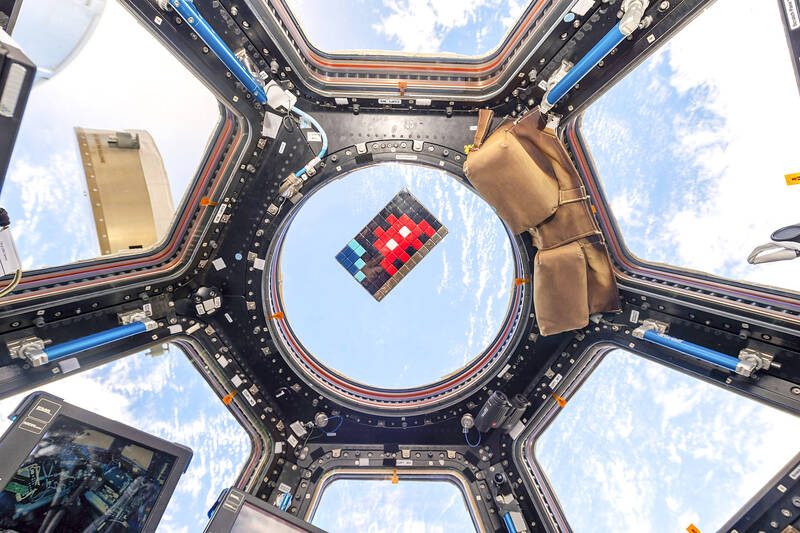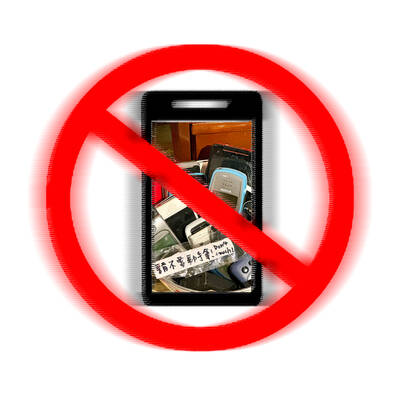For the Paris Olympics, it could almost be a new sport: Score points by hunting down mosaics that a mystery artist who calls himself “Invader” has cemented to walls across France’s capital, the world and even had carried aloft to the International Space Station.
Vincent Giraud, one of the artist’s Parisian fans, is already an avid player. He downloaded Invader’s addictive Flash Invaders mobile-phone game that awards points to users who find and photograph the colorful and quirky pieces of pixelated art.
Quickly hooked, Giraud has in just a year already tracked down 1,565 of them, accumulating so many points that he has rocketed into the leaderboard’s top 1,000, out of more than 360,000 players.

Photo: AP
“In a few months I found and flashed all those in Paris,” says Giraud, game-name Vince-Vader. Hunting for Invader mosaics, looking up and around for them on walls, pavements, bridges and even atop the Eiffel Tower, is “another way of discovering the city.”
Put simply: When Olympic visitors flock in their millions to Paris for the July 26 to Aug. 11 Games, they’ll be crowding onto the turf of France’s most international, invasive and intriguing contemporary street artist. It will be one invasion coming face-to-face with another.
Like Banksy, the British street artist he is sometimes likened to, Invader is elusive, fiercely protective of his anonymity and operating on the margins of illegality. He comes, glues and disappears into the night, leaving behind his signature pixelated mosaics made mostly with small ceramic and glass tiles.
Most resemble the aliens from the Space Invaders arcade game. Others are wonderfully elaborate, such as still lives of fruit or, in New York, portraits of Lou Reed and Andy Warhol. Some reference pop culture — Spiderman, Star Wars, Bugs Bunny, Ninja Turtles, pizza and the like. Some hint at deep research, including a portrait of guitarist Django Reinhardt facing the house where he lived, south of Paris in Samois-sur-Seine.
Since the first cataloged mosaic of a blue Space Invader went up on a Paris street in 1998, numbered PA_01, Invader has colonized the world. There are now more than 4,000 of his mosaics in cities and towns on all continents except Antartica.
London, Tokyo, Los Angeles and other cities were invaded in 1999; New York, Geneva and more in 2000; Hong Kong in 2001; Berlin, Bangkok, Melbourne. On and on.
The 4,000th mosaic was glued to a brick wall in Potosi, 4,000 meters up in the Bolivian Andes, in 2021. The European Space Agency installed Invader’s Space2 mosaic aboard the International Space Station in 2015.
“‘Anytime, Anywhere’ is the philosophy,” he says on his website.
In Paris — by far his most invaded location — the artist’s footprint is larger than ever as the Olympics loom.
A new exhibition in a disused multi-story building has one of his pixelations painted on its roof, visible via satellite on Google Maps. With a telescope, the show’s visitors can also peer across the grey roofs of Paris to Invader’s latest milestone: his 1,500th mosaic in the Olympic host city and its suburbs.
PA_1500 was unveiled last month on an exterior chimney of the Pompidou Center, Paris’ foremost contemporary art museum. Unlike for the bulk of his works which he installs guerrilla-style without asking, Invader sought and got the museum’s permission to cement the red-and-white Space Invader -type alien into place overlooking the city.
“It’s a symbol. It’s number 1,500. It’s Paris,” said Alexandre Aumis, the iconic building’s security director. “It’s got to be here.”
Aumis is a new convert to “Flash Invaders.”
“I run a lot in Paris, so I see them everywhere,” he said.
Some of those who know Invader say they’re expecting him to spring more surprises for the Olympics, perhaps installing new Games-themed mosaics.
“The invasion is the 15 million people who are going to arrive in Paris for the Olympic Games. It’s a lot. Obviously, there will be Invader fans among them,” said Fabrice Bousteau, the editor of Beaux Arts Magazine who curated Invader’s latest exhibition. “So there will be this meeting between two cultures.”
“He will doubtless invade the Games in a different way. I am almost certain.”
That’s thrilling for “Flash Invaders” players.
Niasha Chassain has tracked down just over 50 of the mosaics in Paris and says her children love the hunt.
“It’s a big celebration when we find one,” she said. “It forces you to look up in the street, to look around a bit, to think about turning around, to look in places that are perhaps not so attractive and discover that there are still things to see.”

April 28 to May 4 During the Japanese colonial era, a city’s “first” high school typically served Japanese students, while Taiwanese attended the “second” high school. Only in Taichung was this reversed. That’s because when Taichung First High School opened its doors on May 1, 1915 to serve Taiwanese students who were previously barred from secondary education, it was the only high school in town. Former principal Hideo Azukisawa threatened to quit when the government in 1922 attempted to transfer the “first” designation to a new local high school for Japanese students, leading to this unusual situation. Prior to the Taichung First

The Ministry of Education last month proposed a nationwide ban on mobile devices in schools, aiming to curb concerns over student phone addiction. Under the revised regulation, which will take effect in August, teachers and schools will be required to collect mobile devices — including phones, laptops and wearables devices — for safekeeping during school hours, unless they are being used for educational purposes. For Chang Fong-ching (張鳳琴), the ban will have a positive impact. “It’s a good move,” says the professor in the department of

On April 17, Chinese Nationalist Party (KMT) Chairman Eric Chu (朱立倫) launched a bold campaign to revive and revitalize the KMT base by calling for an impromptu rally at the Taipei prosecutor’s offices to protest recent arrests of KMT recall campaigners over allegations of forgery and fraud involving signatures of dead voters. The protest had no time to apply for permits and was illegal, but that played into the sense of opposition grievance at alleged weaponization of the judiciary by the Democratic Progressive Party (DPP) to “annihilate” the opposition parties. Blamed for faltering recall campaigns and faced with a KMT chair

Article 2 of the Additional Articles of the Constitution of the Republic of China (中華民國憲法增修條文) stipulates that upon a vote of no confidence in the premier, the president can dissolve the legislature within 10 days. If the legislature is dissolved, a new legislative election must be held within 60 days, and the legislators’ terms will then be reckoned from that election. Two weeks ago Taipei Mayor Chiang Wan-an (蔣萬安) of the Chinese Nationalist Party (KMT) proposed that the legislature hold a vote of no confidence in the premier and dare the president to dissolve the legislature. The legislature is currently controlled